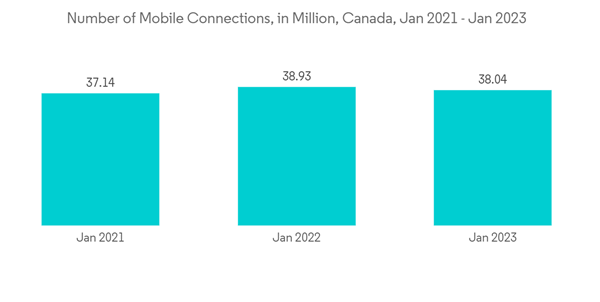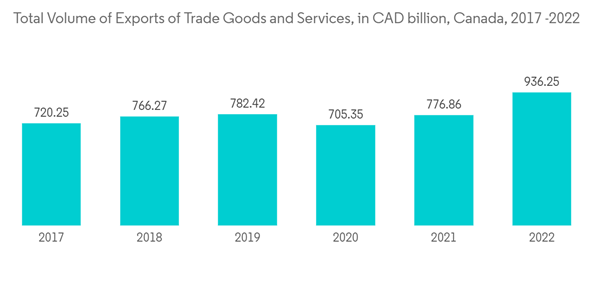The Canada location-based services market size is expected to grow from USD 1.83 billion in the current year to USD 3.24 billion in the next five years at a CAGR of 12.05% during the forecast period.
In November 2022, VeriDaaS Corporation made a significant move by acquiring 4DM, a Canadian geo-intelligence company. 4DM specializes in engaging with non-governmental organizations (NGOs), government entities, and private sector organizations. They focus on intelligent transportation solutions, environmental health, location-based services, and risk assessment applications through consulting projects and service-based work.
In October 2022, GPS Insight, a prominent provider of Software as a Service (SaaS)-based fleet management solutions and field service management software, announced its acquisition of Certified Tracking Solutions. Certified Tracking Solutions is a key player in the fields of GPS telematics, fleet tracking and management, connected transport, and industrial Internet of Things (IoT). Their premier brand, Titan GPS, offers a comprehensive range of fleet management services and support to numerous fleet operators across Canada. This strategic move strengthens GPS Insight's position in the Canadian market.
This product will be delivered within 2 business days.
Key Highlights
- During the past few years, location-based services (LBS) have emerged significantly. It is increasingly used to locate friends in an area, locate the nearest restaurant, or advertise deals to shoppers nearby. LBS enables users to access timely and relevant information about their immediate surroundings while allowing businesses to keep their customers updated on their orders. These LBS applications enhance user experiences by providing a convenient way to interact with businesses.
- The most rapidly advancing positioning methods rely on mobile positioning and satellite-based GPS. With the increasing availability of technologies such as global cell identity (CGICTA) and enhanced observed time differences (E-OTD), the practical precision typically ranges between 50 and 1000 meters. These technologies offer end-users various opportunities depending on the accuracy needed for specific location identification applications.
- Location can be determined using E-OTD, observed timed difference of arrival (OTDOA), wireless-assisted GNSS (A-GNSS), and hybrid technologies, which combine A-GNSS with other standard technologies. Location-based services that track the movement of vehicles can provide commuters and service seekers with improved accuracy in determining their location and real-time estimated arrival times. This enabled them to access more precise and reliable information regarding their current position and expected arrival times. This is expected to gain a significant market base, coupled with the countries' significant efforts worldwide to achieve smooth transportation goals as a part of their smart city projects. These developments are expected to increase opportunities, particularly in the Canadian markets, over the forecast period.
- In addition, the market is witnessing substantial investments in integrating 3D mapping applications with smartphones, attracting key players like Samsung, Nokia, and other original equipment manufacturers (OEMs). These companies actively enter the market, recognizing the potential and value of incorporating 3D mapping capabilities into smartphones. Online web service providers like Microsoft Corp. and Amazon Inc. have started offering 3D maps on their platforms. For instance, in the previous year, Ecopia AI revealed a funding collaboration with Sustainable Development Technology Canada (SDTC) that aims to facilitate the development of high-precision 3D vector maps across the top 100 cities in Canada. These occurrences are anticipated to stimulate demand in emerging economies during the forecast period.
- However, location-based services are revolutionizing various businesses where resource efficiency is crucial. Individuals' positions may be tracked at all times, and LBS gives the visibility needed to keep people safe. As a result, data security and privacy become increasingly important for users, as misuse might result in disastrous consequences. In recent years, the frequency of data breaches has risen considerably due to various applications defying restrictions to access a user's location without authorization.
- Also, post-COVID, there has been a resurgence in the location-based services market as businesses and consumers rely on them for navigation, finding open businesses, and implementing safety measures. Integrating location-based technologies has become crucial for personalized marketing, targeted advertising, and enhancing customer experiences. The market is witnessing a shift towards more advanced and tailored solutions that cater to evolving needs in a post-pandemic world.
Canada Location-Based Services Market Trends
Indoor Location Segment is Expected to Hold Significant Share of the Market
- Indoor LBS is gradually gaining traction due to the increasing penetration of smartphones, the development of sensor technology, and the increase in indoor time. Sensor technology has enabled smart networks to receive data from a smartphone without installing additional devices, making smartphones the most commonly used data source for indoor positioning.
- These sensors or hot spots are called bluetooth low energy (BLE) beacons, which are used to locate devices and users inside a building. Other kinds of indoor positioning being used by organizations are Wi-Fi and Geomagnetic. Thus, IT managers, marketing managers, facilities personnel, and other stakeholders are responsible for purchasing, installing, and maintaining these systems. Indoor tracking applications are beneficial in indoor location tracking/positioning, proximity marketing, and real-time Wayfinding for large facilities, such as airports, hospitals, stadiums, and convention centers.
- There is active research on designing and implementing an indoor positioning platform to back the development of future location-based 5G network functionalities and services. However, the built-in smartphone sensors' readings are easily affected by the surrounding environment and are occasionally different from each other, which adversely influences the accuracy of indoor positioning.
- For instance, the built-in gyroscope sensor and the magnetometer sensor can be used to measure a user's heading direction, which may be different from each other and occasionally from themselves. As a result, this error accumulates, and the user's position may become increasingly inaccurate. Also, the reliability and availability of indoor positioning technologies, up-to-date indoor maps, and privacy concerns associated with location data are some of the most significant challenges to indoor LBS.
- Data from GSMA Intelligence shows 38.04 million cellular mobile connections in Canada at the start of 2023. GSMA Intelligence's numbers indicate that mobile connections in Canada were equivalent to 98.5 percent of the total population in January 2023. Mobile connections in Canada increased by 1.7 million (+4.7 percent) between 2022 and 2023. In several cases, installation and integration services are highly prominent in the market, owing to increased customized and indoor LBS solutions. Installation of hardware and integration of custom technologies into locally deployed applications, etc., are some of the professional services growing faster in the market.
Transportation and Logistics Segment Expected to Hold Significant Share of the Market
- Location-based services find various applications in the transportation industry. In commercial transportation, these services are primarily used in autonomous vehicles or connected vehicles with intelligent devices and advanced features, like GPS and A-GPS, mainly used for location-based services like maps or navigation.
- In transportation, these services are also used for location-based information services, which include the localization of speed cameras, available parking spots, traffic alerts, and dynamic weather updates. Autonomous vehicles are gaining significant traction, with various multinational companies making strides in developing the required technologies.
- Many companies have also been identified as following this trend, which is expected to drive the increase in adoption of autonomous vehicles over the forecast period. Additionally, multinational technological firms, like Facebook, Apple Inc., Alphabet Inc., and Amazon, have been identified as spending heavily on the development of AI-powered cars, thus further propelling the market growth.
- The advent of autonomous vehicles has also resulted in the rise of connected cars, whether vehicle-to-vehicle or vehicle-to-infrastructure, which is expected to augment the growth of the market studied. Navigational maps and live traffic details have been a powerful tool for the automotive industry. They are expected to be even more crucial now, with the vehicle connectivity requirement. The expanded number of sensors incorporated in current vehicles, owing to the development of advanced driver assistance systems (ADAS), has initiated the vendors in the market to innovate their services. For example, HERE is a map and content provider trying to incorporate more information in maps.
- Moreover, advancements in LBS have improved the methods of monitoring and tracking the ships in the recent past. Global satellite services have made ship tracking across the world easier, thus ensuring the safety of vessels from various threats. With the help of transponders installed on the vessels, the satellite collects signals from the vessels to provide their position, route, speed, and ship type. Further, platforms such as Google have improved the ship tracking process, allowing access to minute details of almost all ships within a location.
- According to Statcan, in 2022, Canada exported goods and services worth about CAD 936.25 billion. The infotainment industry is also embracing LBS. In-car infotainment holds opportunities to understand and predict customer needs from consuming content. When the data from infotainment and vehicle are combined, there is a great possibility to cater to the listeners with personalized content.
Canada Location-Based Services Industry Overview
The Canada location-based services market exhibits a moderate level of consolidation, featuring key players such as Cisco Systems Inc., IBM Corporation, Ericsson Inc., Google LLC, ALE International, and various others. These companies consistently invest in strategic partnerships and service advancements to secure a substantial market share. Notable recent developments in the market include:In November 2022, VeriDaaS Corporation made a significant move by acquiring 4DM, a Canadian geo-intelligence company. 4DM specializes in engaging with non-governmental organizations (NGOs), government entities, and private sector organizations. They focus on intelligent transportation solutions, environmental health, location-based services, and risk assessment applications through consulting projects and service-based work.
In October 2022, GPS Insight, a prominent provider of Software as a Service (SaaS)-based fleet management solutions and field service management software, announced its acquisition of Certified Tracking Solutions. Certified Tracking Solutions is a key player in the fields of GPS telematics, fleet tracking and management, connected transport, and industrial Internet of Things (IoT). Their premier brand, Titan GPS, offers a comprehensive range of fleet management services and support to numerous fleet operators across Canada. This strategic move strengthens GPS Insight's position in the Canadian market.
Additional Benefits:
- The market estimate (ME) sheet in Excel format
- 3 months of analyst support
This product will be delivered within 2 business days.
Table of Contents
1 INTRODUCTION
4 MARKET INSIGHTS
5 MARKET DYNAMICS
6 MARKET SEGMENTATION
7 COMPETITIVE LANDSCAPE
Methodology

LOADING...










